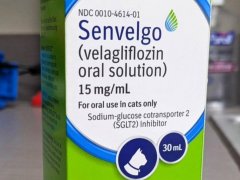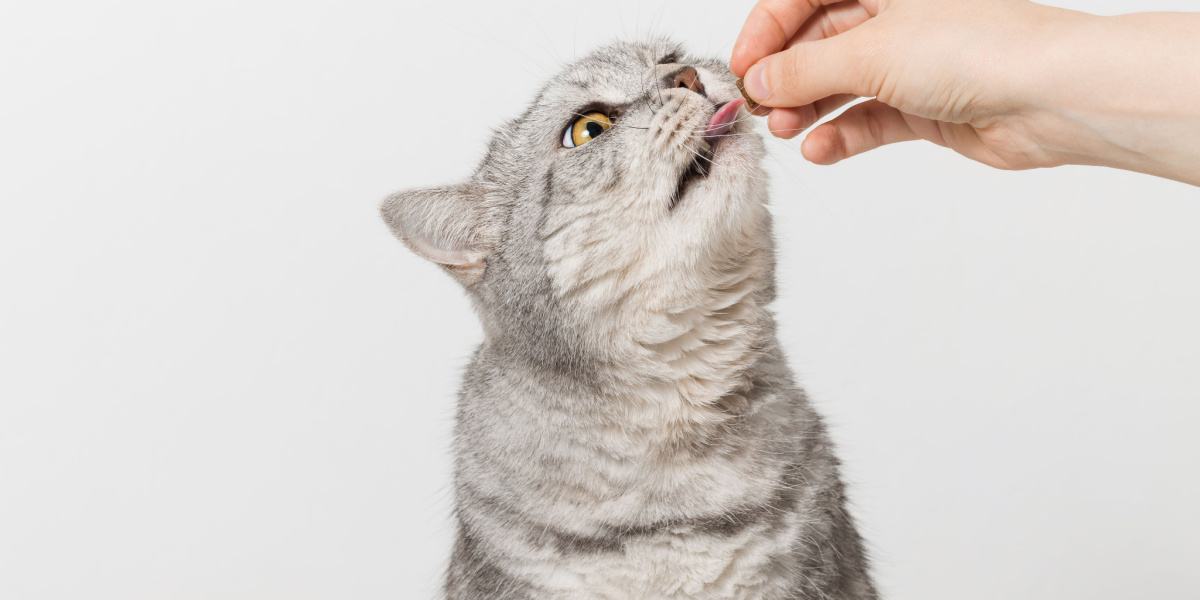
Praziquantel for cats is a common medication used almost exclusively to treat tapeworm infections. In this article you’ll learn what praziquantel is, how it works and when it’s used, potential side effects to consider, and some frequently asked questions.
Praziquantel for Cats Overview

About Praziquantel for Cats
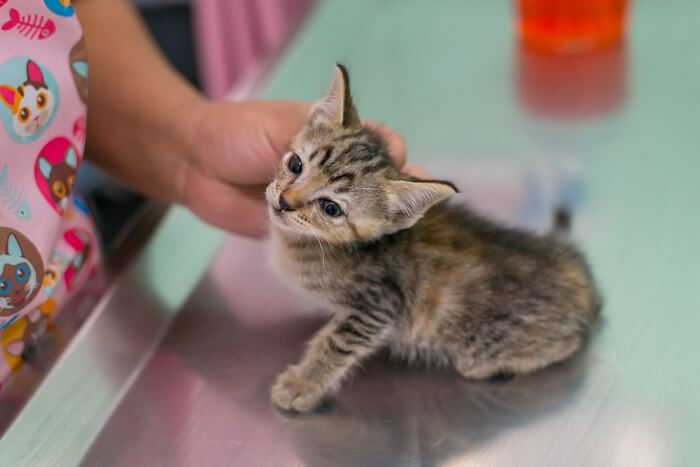
Praziquantel treats two species of tapeworms that commonly infect cats.
Praziquantel is an anthelmintic (dewormer) which is used for the treatment of cestodes, also called tapeworms.
Praziquantel works by interacting with components of the tapeworm’s skin, causing electrolyte disturbance. This paralyzes the tapeworm’s sucker function. It also leads to disintegration of the worm at specific sites of its outer skin layer, which ultimately makes it susceptible to being digested by the host (the cat).
Although praziquantel is the drug of choice for treating tapeworms, it is not considered effective against other types of intestinal parasites. Several products contain combinations of praziquantel with other deworming agents to provide a broader spectrum of coverage.
Praziquantel is FDA-approved for treating specific tapeworms in cats, but it may be used in an off-label manner for a few less common tapeworms, as well as certain lungworms (also called trematodes or flukes).
Also Read: Cat Intestinal Parasites: Causes, Symptoms, & Treatment
What Does Praziquantel Do for Cats?
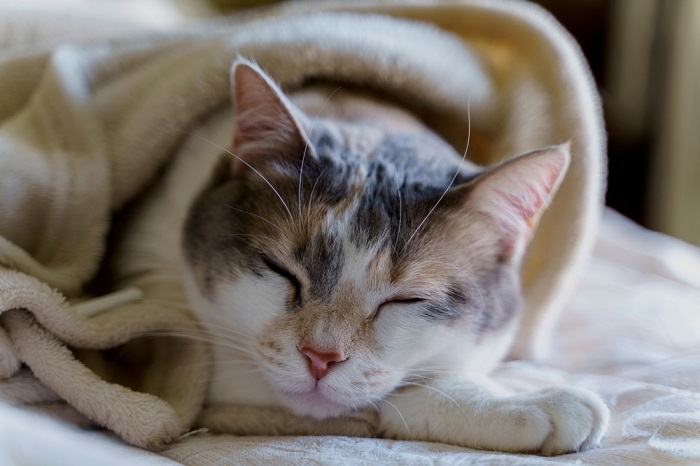
In cats, praziquantel is FDA-approved for treating the tapeworms Dipylidium caninum and Taenia taeniaeformis.
Of the two, Dipylidium caninum is the most commonly seen in cats. Cats typically acquire it by ingesting an infected flea containing the infective stage of the tapeworm called the cysticercoid.
Dipylidium is most commonly reported in cats recently adopted or arriving from shelters who had fleas. Even if the fleas have been effectively treated, the tapeworms might not show up in the cat’s stool for two to three weeks. Ironically, even a cat on flea prevention can still acquire this tapeworm if the cat hunts and ingests a flea from the environment.
Cats can acquire Taenia taeniaeformis by preying on rodents or other small animals that contain the encysted larval stage of the tapeworm. Taenia infection is most common in cats that go outdoors that are engaged actively in hunting and ingesting their prey.
Tapeworm eggs do not commonly present in stool samples, but cat owners often see small, rice-like worm segments around their cat’s bottom or in fresh stool. Tapeworms can lead to weight loss, though initially most cats with tapeworms show no signs of disease.
Praziquantel is very effective against both of these tapeworms, with a single dose often being sufficient. However, some veterinarians might recommend repeating a dose in two to three weeks, depending on the form of praziquantel being used.
Also Read: Vet Approved Cat Stool Chart: Decoding Your Cat’s Poop
Side Effects of Praziquantel for Cats
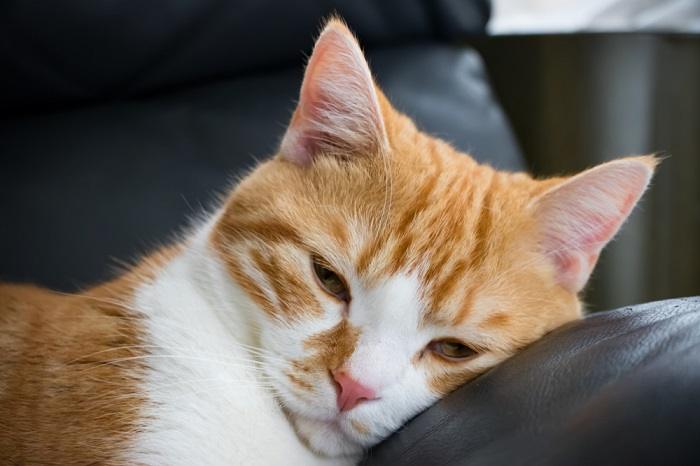
Praziquantel is safe and effective against tapeworms, with few side effects.
Fortunately, cats often tolerate praziquantel very well with fewer than 2% of cats showing adverse effects in field studies.
When side effects do occur, the most commonly reported signs are hypersalivation (drooling) and diarrhea. In cats with higher worm burdens, diarrhea is sometimes seen as the worms are dying and being broken down by the body.
Praziquantel should not be used in kittens younger than 6 weeks of age. Praziquantel appears to be safe to use in pregnant queens, though caution should be taken if using a combination product, as other ingredients might not carry approvals for pregnancy. It also appears to be safe to use praziquantel in the queen when the kittens are still nursing, though it should not be used on the kittens themselves.
Praziquantel has a very wide margin of safety when used properly. However, very high overdoses (at least more than 10 times the appropriate dosage) can have concerning effects, including vomiting, muscle tremors, difficulty walking, depression, and even death.
If you are ever concerned that your cat might have developed side effects while using praziquantel, or if an overdose is suspected, make sure to contact your veterinarian, the ASPCA Animal Poison Control Center (1-888-426-4435), or Pet Poison Helpline (1-855-764-7661) immediately for further advice.
Also Read: Drug Poisoning In Cats: Causes, Symptoms, & Treatment
Praziquantel for Cats Dosage
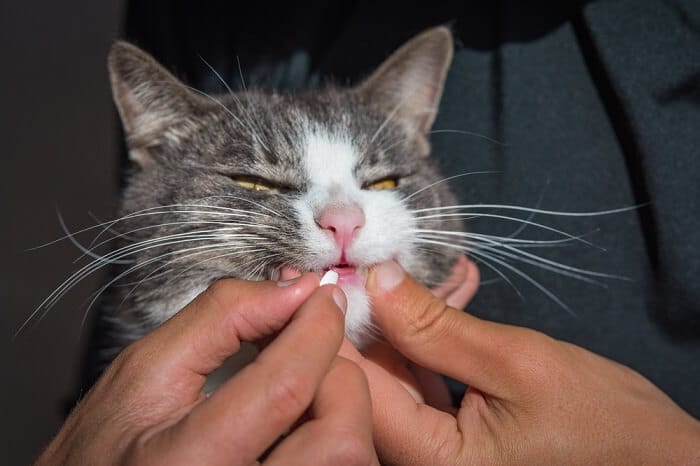
Praziquantel comes most commonly in two forms, either as an oral tablet or as a topical solution applied to the skin, similar to some flea/tick products like Frontline or Revolution.
Droncit Oral Tablets
Droncit, a brand of oral praziquantel manufactured by Bayer Animal Health, which is FDA-approved for use in cats and kittens at least 6 weeks old, has the following dosage instructions using the 23 milligram tablet:
- Cats 4 pounds (1.8 kilograms) and under: 0.5 tablet
- Cats 5 to 11 pounds (2.3 to 5 kilograms): 1 tablet
- Cats more than 11 pounds (5 kilograms): 1.5 tablets
Drontal Oral Tablets
Drontal, also manufactured by Bayer Animal Health, contains pyrantel pamoate in addition to praziquantel. This increases the spectrum of action to include hookworms and roundworms and is FDA-approved for use in cats and kittens at least 2 months of age and weighing at least 2 pounds (0.9 kilograms).
Drontal tablets for cats and kittens contain 18.2 milligrams praziquantel and 72.6 milligrams pyrantel. The following dosage instructions are provided according to the manufacturer:
- Cats weighing 2 to 3 pounds (0.9 to1.4 kilograms): 0.5 tablet
- Cats 4 to 8 pounds (1.8 to 3.6 kilograms): 1 tablet
- Cats 9 to 12 pounds (4.1 to 5.4 kilograms): 1.5 tablets
- Cats 13 to 16 pounds (5.9 to 7.3 kilograms): 2 tablets
One dose is often sufficient for both Drontal and Droncit, but some veterinarians might recommend a second dose in two to three weeks, especially with high parasite burdens.
Profender Topical Solution
Profender, manufactured by Bayer Animal Health, provides a non-oral option to treat cats for tapeworms. In addition to tapeworms, it is also indicated for treating roundworms and hookworms.
Profender comes in three dosage sizes:
- Small for cats weighing 2.2 to 5.5 pounds
- Medium for cats weighing 5.6 to 11 pounds
- Large is for cats weighing 11.1 to 17.6 pounds
For cats weighing more than this, the manufacturer recommends combining the appropriate sizes to treat for the full weight of the cat. For example, a cat weighing 20 pounds would get both a large dose and a small dose applied topically.
Profender is administered similar to topical flea/tick preventative medications by applying the solution to the skin at the back of the neck or base of the head by parting the fur. For Profender, the cap must be removed, turned over, placed into the tip of the tube and twisted to break the seal before applying.
Profender lasts for 30 days, so in most cases, a single application is all that is needed to treat a tapeworm infection, as long as the underlying source (fleas or predation of a smaller tapeworm host) is addressed.
Centragard Topical Solution
Centragard, manufactured by Boehringer Ingelheim, is another topical product that treats tapeworms. Centragard contains praziquantel as well as eprinomectin. In addition to treating tapeworms, Centragard also treats roundworms and hookworms, and prevents mosquito-borne heartworm disease. Centragard is FDA-approved for cats and kittens at least 7 weeks of age and weighing at least 1.8 pounds.
Centragard comes in two dosage sizes:
- 0.3 milliliters for cats weighing 1.8 to 5.5 pounds
- 0.9 milliliters for cats weighing 5.5 to 16.5 pounds
Similar to Profender, cats weighing more than 16.5 pounds should receive a combination. The manufacturer recommends combining the 0.9ml with an additional 0.3ml size for cats weighing up to 22 pounds, and combining two of the 0.9ml sizes for cats weighing 22.1 to 33 pounds.
To apply Centragard, which comes in a syringe with a plunger, slightly pull the plunger back, remove the cap, then apply the product to the skin between parted fur at the base of the head/back of the neck.
Like Profender, Centragard also stays in effect for 30 days, effectively treating most tapeworm infections with a single application.
After providing tapeworm treatment to your cat, the best way to determine if any further doses may be needed is to monitor for any reoccurring rice-like segments around your cat’s anal area or on fresh stool. Tapeworm eggs do not present in most fecal samples run using traditional methods at veterinary clinics and labs.
Also Read: Cat Suddenly Lethargic and Weak: Causes & Treatment
In Summary
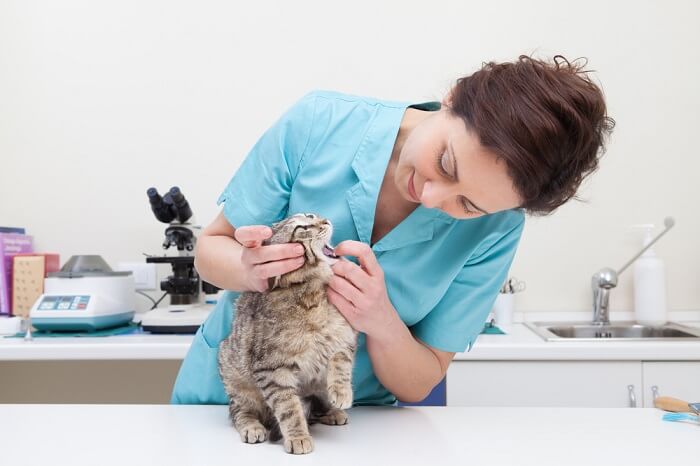
Praziquantel only treats tapeworms—other parasites require different drugs to eliminate them.
Praziquantel is a dewormer used primarily to treat tapeworms in cats. It does not otherwise have a very broad spectrum against other intestinal worms, though may be combined with other products to provide better coverage. It is generally well-tolerated with both oral and topical forms being available for use in cats.
Drug Dosing Disclaimer: We are only able to provide doses for medications that are FDA approved for use in cats and only as the label guidelines dictate. For medications that are used off-label we can only provide guidelines and safety information for use. Safe and appropriate dosing for off-label medications can only be determined by a primary care veterinarian.
We encourage you to work with your veterinarian to determine if a particular medication is appropriate for your cat. Changing or adjusting a dose for your cat on your own without consulting with a veterinarian can carry risk. We do not encourage use of medications prescribed for human use in pets without first consulting with a primary care veterinarian.
Frequently Asked Questions
How long does it take for praziquantel to work in cats?
Praziquantel generally works pretty quickly after being administered, usually within 24 hours. In dogs, peak concentrations occur within 30 minutes to two hours, and the effect is likely similar in cats. The drug is then readily taken in by the parasite, leading quickly to paralysis, death, and ultimate digestion by the host (the cat).
What does praziquantel treat in cats?
Praziquantel is used primarily to treat tapeworms in cats, and is FDA-approved for treating the most common ones, Dipylidium caninum and Taenia taeniaeformis. It can also be used in an off-label manner to treat some less common tapeworms as well as trematodes or flukes, which are other types of parasitic worms.
Do you need a prescription for praziquantel for cats?
Depending on the product, praziquantel may be obtained without a prescription. However, some products, especially those in combination with other drugs, may require one.
How many praziquantel tablets do I give my cat?
This may depend on the product being used, but for 23 milligram praziquantel tablets as found in Droncit for Cats, the dosing is as follows, according to the manufacturer:
Cats 4 pounds (1.8 kilograms) and under: 0.5 tablets
Cats 5 to 11 pounds (2.3 to 5 kilograms): 1 tablet
Cats more than 11 pounds (5 kilograms): 1.5 tablets
If you don’t have this tablet size or brand, or if you have a product intended for dogs, do not administer this to your cat without first consulting with your veterinarian for safety information and proper dosing if possible.


